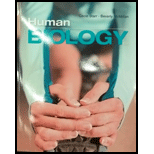
Concept explainers
Define the difference between (a) gene and allele, (b) dominant allele and recessive allele, (c) homozygote and heterozygote, and (d) genotype and
(a)
To differentiate: Gene and allele
Introduction: Genetics is the study of genes and their inheritance patterns. Allele and gene are two common terms used in genetics.
Explanation of Solution
A gene includes a set of nucleotides that code for a particular trait.
An allele is a variant of a gene for the same trait coded by the gene.
(b)
To differentiate: Dominant and recessive allele.
Introduction: Genetics is the study of genes and their inheritance patterns. An allele is a variant of a gene for the same trait coded by the gene. Dominant and recessive alleles are two common terms used in genetics.
Explanation of Solution
The allele that is expressed in the heterozygous condition of two alleles is called as a dominant allele.
The recessive allele can be expressed only in homozygous condition. In heterozygous condition, the dominant allele masks its effects.
(c)
To differentiate: Homozygote and heterozygote.
Introduction: Genetics is the study of genes and their inheritance patterns. Homozygote and heterozygote are two common terms used in genetics. An allele is a variant of a gene for the same trait coded by the gene. Homologous chromosomes are a pair of chromosomes where one chromosome was obtained from the male gamete and the other from the female gamete at the time of the union of the nucleus during formation of zygote.
Explanation of Solution
The homozygote or homozygous condition is where the same allele is present on both the homologous chromosomes. Both the alleles are either dominant or recessive.
The heterozygote or heterozygous condition is where different alleles are present on both the homologous chromosomes. One allele is dominant and the other is recessive.
(d)
To differentiate: Genotype and phenotype
Introduction: Genetics is the study of genes and their inheritance patterns. Genotype and phenotype are two common terms used in genetics.
Explanation of Solution
The genetic makeup of an organism having genes that code for a particular trait of an individual trait is called as genotype.
The morphological or biochemical or physiological expression of the trait of the gene that encodes the trait is called the phenotype.
Want to see more full solutions like this?
Chapter 19 Solutions
Human Biology (MindTap Course List)
- students in a science class investiged the conditions under which corn seeds would germinate most successfully. BAsed on the results which of these factors appears most important for successful corn seed germination.arrow_forwardI want to write the given physician orders in the kardex formarrow_forwardAmino Acid Coclow TABle 3' Gly Phe Leu (G) (F) (L) 3- Val (V) Arg (R) Ser (S) Ala (A) Lys (K) CAG G Glu Asp (E) (D) Ser (S) CCCAGUCAGUCAGUCAG 0204 C U A G C Asn (N) G 4 A AGU C GU (5) AC C UGA A G5 C CUGACUGACUGACUGAC Thr (T) Met (M) lle £€ (1) U 4 G Tyr Σε (Y) U Cys (C) C A G Trp (W) 3' U C A Leu בוט His Pro (P) ££ (H) Gin (Q) Arg 흐름 (R) (L) Start Stop 8. Transcription and Translation Practice: (Video 10-1 and 10-2) A. Below is the sense strand of a DNA gene. Using the sense strand, create the antisense DNA strand and label the 5' and 3' ends. B. Use the antisense strand that you create in part A as a template to create the mRNA transcript of the gene and label the 5' and 3' ends. C. Translate the mRNA you produced in part B into the polypeptide sequence making sure to follow all the rules of translation. 5'-AGCATGACTAATAGTTGTTGAGCTGTC-3' (sense strand) 4arrow_forward
- What is the structure and function of Eukaryotic cells, including their organelles? How are Eukaryotic cells different than Prokaryotic cells, in terms of evolution which form of the cell might have came first? How do Eukaryotic cells become malignant (cancerous)?arrow_forwardWhat are the roles of DNA and proteins inside of the cell? What are the building blocks or molecular components of the DNA and proteins? How are proteins produced within the cell? What connection is there between DNA, proteins, and the cell cycle? What is the relationship between DNA, proteins, and Cancer?arrow_forwardWhy cells go through various types of cell division and how eukaryotic cells control cell growth through the cell cycle control system?arrow_forward
 Human Biology (MindTap Course List)BiologyISBN:9781305112100Author:Cecie Starr, Beverly McMillanPublisher:Cengage Learning
Human Biology (MindTap Course List)BiologyISBN:9781305112100Author:Cecie Starr, Beverly McMillanPublisher:Cengage Learning Concepts of BiologyBiologyISBN:9781938168116Author:Samantha Fowler, Rebecca Roush, James WisePublisher:OpenStax College
Concepts of BiologyBiologyISBN:9781938168116Author:Samantha Fowler, Rebecca Roush, James WisePublisher:OpenStax College Biology (MindTap Course List)BiologyISBN:9781337392938Author:Eldra Solomon, Charles Martin, Diana W. Martin, Linda R. BergPublisher:Cengage Learning
Biology (MindTap Course List)BiologyISBN:9781337392938Author:Eldra Solomon, Charles Martin, Diana W. Martin, Linda R. BergPublisher:Cengage Learning Human Heredity: Principles and Issues (MindTap Co...BiologyISBN:9781305251052Author:Michael CummingsPublisher:Cengage Learning
Human Heredity: Principles and Issues (MindTap Co...BiologyISBN:9781305251052Author:Michael CummingsPublisher:Cengage Learning
 Anatomy & PhysiologyBiologyISBN:9781938168130Author:Kelly A. Young, James A. Wise, Peter DeSaix, Dean H. Kruse, Brandon Poe, Eddie Johnson, Jody E. Johnson, Oksana Korol, J. Gordon Betts, Mark WomblePublisher:OpenStax College
Anatomy & PhysiologyBiologyISBN:9781938168130Author:Kelly A. Young, James A. Wise, Peter DeSaix, Dean H. Kruse, Brandon Poe, Eddie Johnson, Jody E. Johnson, Oksana Korol, J. Gordon Betts, Mark WomblePublisher:OpenStax College





